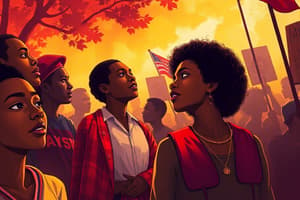Podcast
Questions and Answers
Who was known for his advocacy of nonviolent protest and civil disobedience?
Who was known for his advocacy of nonviolent protest and civil disobedience?
- John Lewis
- Rosa Parks
- Martin Luther King Jr. (correct)
- Ella Baker
What was the significance of the Greensboro sit-ins in 1960?
What was the significance of the Greensboro sit-ins in 1960?
- It led to the desegregation of public facilities in the South (correct)
- It sparked a wave of riots across the country
- It marked the beginning of the Civil Rights Movement
- It resulted in the arrest of many civil rights activists
Who was the six-year-old African American girl who integrated William Frantz Elementary School in New Orleans?
Who was the six-year-old African American girl who integrated William Frantz Elementary School in New Orleans?
- Rosa Parks
- Ruby Bridges (correct)
- Fannie Lou Hamer
- Ella Baker
What was Emmett Till known for?
What was Emmett Till known for?
Who were the three civil rights activists abducted and murdered by the Ku Klux Klan in 1964?
Who were the three civil rights activists abducted and murdered by the Ku Klux Klan in 1964?
What was the outcome of the Plessy v. Ferguson ruling in 1896?
What was the outcome of the Plessy v. Ferguson ruling in 1896?
What was the main purpose of the Black Codes enacted in the Southern United States during the Reconstruction era?
What was the main purpose of the Black Codes enacted in the Southern United States during the Reconstruction era?
What was the name of the affluent African American neighborhood that was attacked by a white mob in 1921?
What was the name of the affluent African American neighborhood that was attacked by a white mob in 1921?
What was the primary target of the Zoot Suit Riots in 1943?
What was the primary target of the Zoot Suit Riots in 1943?
What was the outcome of the landmark Supreme Court case Brown v. Board of Education in 1954?
What was the outcome of the landmark Supreme Court case Brown v. Board of Education in 1954?
Flashcards are hidden until you start studying
Study Notes
People
- Martin Luther King Jr. was a leader of the Civil Rights Movement, advocating for nonviolent protest and civil disobedience.
- Rosa Parks was an activist who refused to give up her seat to a white passenger, sparking the Montgomery Bus Boycott.
- Ella Baker was a civil rights activist and organizer who played a key role in the Southern Christian Leadership Conference (SCLC) and the Student Nonviolent Coordinating Committee (SNCC).
- Fannie Lou Hamer was a voting rights activist and co-founder of the Mississippi Freedom Democratic Party, working to increase African American political participation.
- John Lewis was a civil rights leader and congressman who participated in the Selma to Montgomery marches and advocated for voting rights.
- Emmett Till was an African American teenager whose brutal murder in 1955 drew national attention to the violence and racism faced by African Americans in the South.
- James Chaney, Andrew Goodman, and Michael Schwerner were civil rights activists murdered by the Ku Klux Klan in 1964 while working to register African American voters in Mississippi.
- James Earl Ray assassinated Martin Luther King Jr. in 1968.
Events, Laws, and Cases
- The Plessy v. Ferguson (1896) ruling upheld the constitutionality of racial segregation laws for public facilities under the doctrine of "separate but equal."
- Black Codes (1865-1877) were laws enacted in the Southern United States to maintain control over the newly freed African American population and preserve the pre-war social order.
- Jim Crow laws (1870’s-1960’s) were a system of racial segregation and discrimination that became entrenched in Southern society following the Reconstruction period.
- The Tulsa Race Massacre (1921) occurred in the Greenwood District of Tulsa, Oklahoma, when a white mob attacked the affluent African American neighborhood of Greenwood.
- The Zoot Suit Riots (1943) were a series of racially motivated attacks in Los Angeles, California, targeting Mexican American youths who wore distinctive clothing.
- The Brown v. Board of Education (1954) case declared state laws establishing separate public schools for black and white students unconstitutional.
- The Greensboro sit-ins (1960) were nonviolent protests in Greensboro, North Carolina, where four African American college students sat at a segregated Woolworth's lunch counter, sparking a wave of sit-ins across the South.
- Ruby Bridges integrated William Frantz Elementary School in New Orleans, Louisiana, in 1960, symbolizing the struggle for school desegregation.
Studying That Suits You
Use AI to generate personalized quizzes and flashcards to suit your learning preferences.




